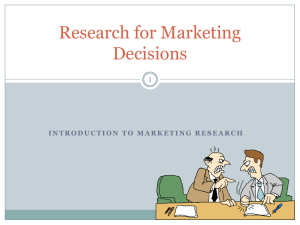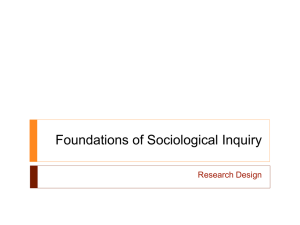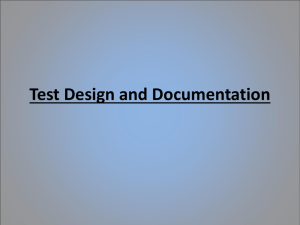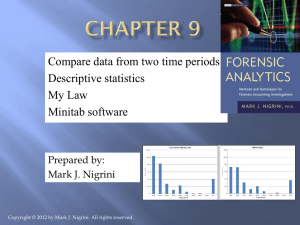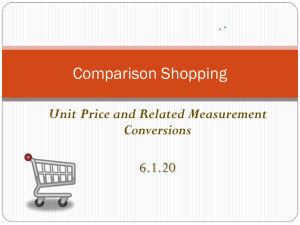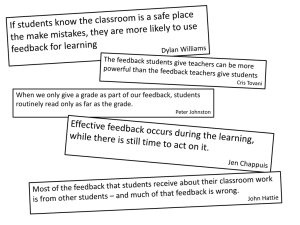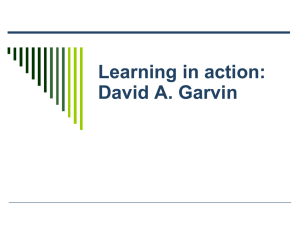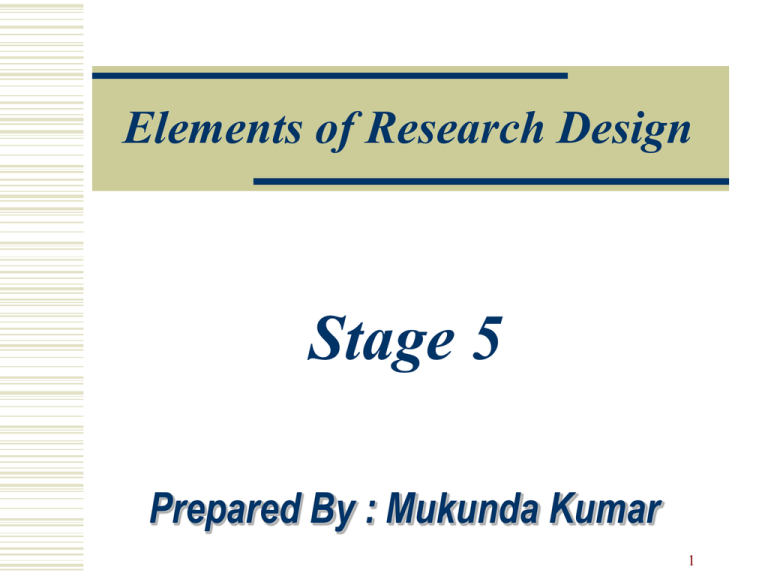
Elements of Research Design
Stage 5
Prepared By : Mukunda Kumar
1
The Research Design
The research design involves a series of rational decision-making
choices.
The various issue involved in the research design:
Purpose for the study (exploratory, descriptive, hypothesis
testing),
its location (i.e., the study setting),
the type it should conform to (type of investigation),
2
The Research Design
The various issue involved in the research
design:
the extent to which it is manipulated and controlled
by the researcher (extent of researcher interference),
its temporal aspects (time horizon), and
the level at which the data will be analyzed (unit of
analysis), are integral to research design.
3
Purpose Of The Study: Exploratory, Descriptive
Exploratory Study
An exploratory study is undertaken when not much is
known about the situation at hand, or no information is
available on how similar problems or research issues
have been solved in the past.
In such cases, extensive preliminary work needs to be
done to gain familiarity with the phenomena in the
situation, and understand what is occurring, before we
develop a model and set up a rigorous design for
comprehensive investigation.
4
Purpose Of The Study: Exploratory, Descriptive
Exploratory Study
Exploratory studies are undertaken to better
comprehend the nature of the problem since very few
studies might have been conducted in that area.
Extensive interviews with many people might have to
be undertaken to get a handle on the situation and
understand the phenomena.
More rigorous research could then proceed.
5
Purpose Of The Study: Exploratory, Descriptive
Exploratory Study
Some qualitative studies (as opposed to quantitative data
gathered through questionnaires, etc.) where data are
collected through observation or interviews, are
exploratory in nature.
For example, Henry Mintzberg interviewed managers to
explore the nature of managerial work.
Based on the analysis of his interview data, he
formulated theories of managerial roles, the nature and
types of managerial activities.
6
Purpose Of The Study: Exploratory, Descriptive
Exploratory Study
Exploratory studies are also necessary when some facts
are known, but more information is needed for
developing a viable theoretical framework.
For instance, when we want to get at the important
factors that influence the advancement of women in
organizations, previous studies might indicate that
women are increasingly taking on qualities such as
assertiveness, competitiveness and independence.
7
Purpose Of The Study: Exploratory, Descriptive
Exploratory Study
There is also a perception that a judicious blend of
masculine and feminine traits – such as being strong
but not tough, kind but not soft – is conducive to
women’s organizational advancement.
These notions apart, there is a need for interviewing
women managers who have made it to the top to
explore all the relevant variables.
8
Purpose Of The Study: Exploratory, Descriptive
Exploratory Study
Exploratory studies are important for obtaining a good
grasp of the phenomena of interest and advancing
knowledge through subsequent theory building and
hypothesis testing.
9
Purpose Of The Study: Exploratory, Descriptive
Descriptive Study
A descriptive study is undertaken in a order to ascertain
and be able to describe the characteristics of the
variables of interest in a situation.
A study of a class in terms of the percentage of
members who are in their senior and junior years, sex
composition, age groupings number of semesters left
until graduation, and number of business course taken,
can be considered as descriptive in nature.
10
Purpose Of The Study: Exploratory, Descriptive
Descriptive Study
Descriptive studies are undertaken in organizations to
learn about and describe the characteristics of a group
of employees, as for example, the age, educational
level, job status, and length of service of Hispanics or
Asian, working in the system.
Descriptive studies are also undertaken to understand
the characteristics of organizations that implement
flexible manufacturing system (FMS) or that have a
certain debt-to-equity ratio.
11
Purpose of the Study: Exploratory
and Descriptive
The goal of a descriptive study is to offer to the
researcher a profile or to describe relevant aspects
of the phenomena of interest from:
An individual,
Organizational
Industry-oriented or
Other perspectives.
12
Purpose Of The Study: Exploratory, Descriptive
Descriptive Study
Description studies that present data in a meaningful form thus
help to
(1) understand the characteristics of a group in a given
situation,
(2), think systematically about aspects in a given situation,
(3) offer ideas for further probe and research, and/or
(4) help make certain simple decisions (such as how many and
what kinds of individuals should be transferred from one
department to another).
13
Purpose Of The Study: Exploratory, Descriptive
Examples of situations warranting a descriptive study
Example 1
A bank manager wants to have a profile of the individual who have
loan payments outstanding for six months and more.
It would include details of their average age, earnings, nature of
occupation, full time/part time employment status and the like.
This might help him to elicit further information or decide right
away on the types of individuals who should be made ineligible
for loan in the future.
14
Purpose Of The Study: Exploratory, Descriptive
Example 2
A CEO may be interested in having a description of
organizations in her industry that follow the LIFO
system.
In this case, the report might include the age of the
organizations, their locations, their production levels,
assets, sales, inventory levels, suppliers, and profits.
Such information might allow comparison later of the
performance levels of specific types of companies.
15
Type Of Investigation: Casual Versus
Correlational
A manager should determine whether a casual or a correlational
study is needed to find an answer to the issue at hand.
The former is done when it is necessary to establish a definitive
cause-and-effect relationship.
If all that the manager wants is a mere identification of the
important factors “associated with the problem, then a
correlational study is called for.
In the former case, the researcher is keen on delineating one or
more factors that are undoubtedly causing the problem.
16
Type Of Investigation: Casual Versus
Correlational
The intention of the researcher conducting a causal
study is to be able to state that variable X causes variable
Y. So, when variable X is removed or altered in some
way, problem Y is solved.
The study in which the researcher wants to delineate that
cause of one or more problems is called a causal study.
17
Type Of Investigation: Casual Versus
Correlational
When the researcher is interested in
delineating the important variables
associated with the problem, the study is
called a correlational study.
Whether a study is a causal or a correlational
one depends on the type of research
questions asked and how the problem is
defined.
18
Type Of Investigation: Casual Versus
Correlational
Example 1
The following example will illustrate the difference :
A causal study question:
Does smoking cause cancer?
A correlation study question:
Are smoking and cancer related? OR
Are smoking, drinking, and chewing tobacco associated with
cancer? If so, which of these contributes most to the variance in
the dependent variable?
19
Type Of Investigation: Casual Versus
Correlational
Example 2
Fears of an earthquake predicted recently in the New
Madrid fault zone were instrumental (i.e., causal) in
an unprecedented number of house owners in the
Midwest region taking out an earthquake insurance
policy.
20
Type Of Investigation: Casual Versus
Correlational
Example 3
Increase in interest rates and property taxes,
the recession, and the predicted earthquake
considerably slowed down the business of
real estate agents in the Midwest.
21
Type Of Investigation: Casual Versus
Correlational
In example 2, it indicates a causal relationship
between the earthquake prediction and earthquake
insurance.
Under Example 3, it indicates the several factors,
including the predicted earthquake influenced (not
caused) the slowdown of real estate agents’
business.
This is a correlational study, which was not
intended to establish a cause-and-effect
relationship.
22
Unit Of Analysis: Individuals, Dyads, Groups,
Organizations And Cultures.
The init of analysis refers to the level of aggregation of
the data collected during the subsequent data analysis
stage.
If the problem statement focuses on how to raise the
motivational levels of employees in general, then we are
interested in individual employees in the organization
and would have to find out what we can do to raise their
motivation.
23
Unit Of Analysis: Individuals, Dyads, Groups,
Organizations And Cultures.
Here the unit of analysis is the individual. We will be
looking at the data gathered from each individual and
treating each employee’s response as an individual data
source.
If the researcher is interested in studying two – person
interactions, then several two-person groups, also known
as dyads, will become the unit of analysis.
24
Unit Of Analysis: Individuals, Dyads, Groups,
Organizations And Cultures.
Analysis of husband- wife interaction in families and
supervisor-subordinate relationship at the workplace are
good examples of dyads as the unit of analysis.
If
the
problem
statement
is
related
to
group
effectiveness, then the unit of analysis would be at the
group level.
25
Unit Of Analysis: Individuals, Dyads, Groups,
Organizations And Cultures.
Even though we may gather relevant data from all individual
comprising, say, six groups, we would aggregate the individual
data into group data so as to see the differences among the six
groups.
If we compare different departments in the organization, then the
data analysis will be done at the departmental level – that is, the
individuals in the department will be treated as one unit – and
comparisons made treating the department as the unit of analysis.
26
Unit Of Analysis: Individuals, Dyads, Groups,
Organizations And Cultures.
Example 1
Individuals As The Unit Of Analysis
The chief financial officer of a manufacturing company wants
to know how many of the staff would be interested in
attending a 3-day seminar on making appropriate investment
decisions.
For this purpose, data will have to be collected from each
individual staff member and the unit of analysis is the
individual.
27
Unit Of Analysis: Individuals, Dyads, Groups,
Organizations And Cultures.
Example 2
Dyads As The Unit Of Analysis
Having read about the benefits of mentoring, a human
resources manager wants to first identify the number of
employees in three departments of the organization who are in
mentoring relationship, and then find out what the jointly
perceived benefits (i.e., by both the mentor and one mentored)
of such a relationship are.
28
Unit Of Analysis: Individuals, Dyads, Groups,
Organizations And Cultures.
Example 2
Dyads As The Unit Of Analysis
Here, once the mentor and the mentored pairs are identified,
their joint perceptions can be obtained by the treating each pair
as one unit.
Hence, if the manager wants data from a sample of 10 pairs, he
will have to deal with 20 individuals, a pair at a time. The
information obtained from each pair will be a data point of
subsequent analysis.
Thus, the unit of analysis here is the dyad.
29
Unit Of Analysis: Individuals, Dyads, Groups,
Organizations And Cultures.
Example 3
Groups As The Unit Of Analysis
A manger wants to see the patterns of usage of the newly installed
information system (IS) by the production, sales, and operations
personnel.
Here three group of personel are involved and information on the
number of times the IS used by member in each of the three groups
as well as other relevant issues will be collected and analyzed.
The final result will indicate the mean usage of the system per day
or mouth for each group. Here the unit of analysis is the group.
30
Time horizon; cross-sectional versus
longitudinal studies
Cross-sectional studies
A study can be done in which data are gathered just
once, perhaps over a period of days or weeks or
months, in order to answer a research question.
Such a studies are called one-shot or cross-sectional
studies.
31
Time horizon; cross-sectional versus
longitudinal studies
Example 1
Data were collected from stock brokers between April and
June of last year to study their concerns in a turbulent stock
market.
Data with respect to this particular research had not been
collected before, nor will they be collected again from them
for this research.
32
Time horizon; cross-sectional versus
longitudinal studies
Example 2
A drug company desirous of investing in research for
a new obesity (reduction) pill conducted a survey
among obese people to see how many of them would
be interested in trying the new pill.
This is a one-shot or cross-sectional study to asses the
likely demand for the new product.
33
Time horizon; cross-sectional versus
longitudinal studies
The purpose of both the studies in the two foregoing
examples was to collect data that would be pertinent
to find the answer to research question.
Data collection at one point in time was sufficient.
Both were cross-sectional designs.
34
Time horizon; cross-sectional versus
longitudinal studies
Longitudinal Studies
In some cases the researcher might want to study people or
phenomena at more than one point in time in order to answer the
reach question.
The researcher might want to study employees’ behavior before
and after a change in the top management, so as to know what
effects the change accomplished.
Data are gathered at two different points in time, the study is not
cross-sectional or of the one-shot kind, but is carried
longitudinally across a period of time.
35
Time horizon; cross-sectional versus
longitudinal studies
Example 1
UPS experienced a shutdown for 15 days during the
teamsters’ walkout and their clients shifted their business to
other carries such as FedEx and the U.S Postal Service.
After the termination of the strike, UPS tried to woo their
customers back through several strategies and collected data
month after month to see what progress they were making
in this regard.
36
Time horizon; cross-sectional versus
longitudinal studies
Example 1
Here, data were collected every month to asses whether
UPS had regained the business volume.
Since data were collected at various points in time to
answer the same research questions (have we regained lost
ground) the study is a longitudinal.
37
Time horizon; cross-sectional versus
longitudinal studies
Example 2
A marketing manager is interested in tracing the pattern of
sales of a particular product in four different regions of
country on a quarterly basis for the next years.
Since data are collected several times to answer the same
issue (tracing pattern of sales) the study falls under the
longitudinal category.
38

